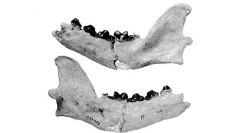

 Geodiversitas
27 (4) - Pages 567-590
Geodiversitas
27 (4) - Pages 567-590Volcanic ashes in Akkașdağı (Turkey) have yielded well preserved remains of late Miocene Carnivora belonging to three families. The Hyaenidae are the most abundant. Adcrocuta eximia, a very common large animal, and Ictitherium viverrinum were first described from the Greek locality Pikermi. The type specimen of Hyaenictitherium wongii has been found in China but the species is also present in European or Western Eurasian localities. Thalassictis spelaea and cf. Thalassictis sp. are less common but they were recovered from several European localities. The felid Felis cf. attica is a cat which is similar in size to Leptailurus serval; its type locality is Pikermi but it has also been found at some other sites in Europe and Asia. Another, larger felid is known from some limb bones. Skunks are not very common in Asian or European fossil localities. Nevertheless several species have been described. The Akkas.dag˘ı skunk belongs to Promephitis hootoni.
Mammalia, Carnivora, Hyaenidae, Felidae, Mustelidae, late Miocene, Turolian, Akkașdağı, Central Anatolia, Turkey